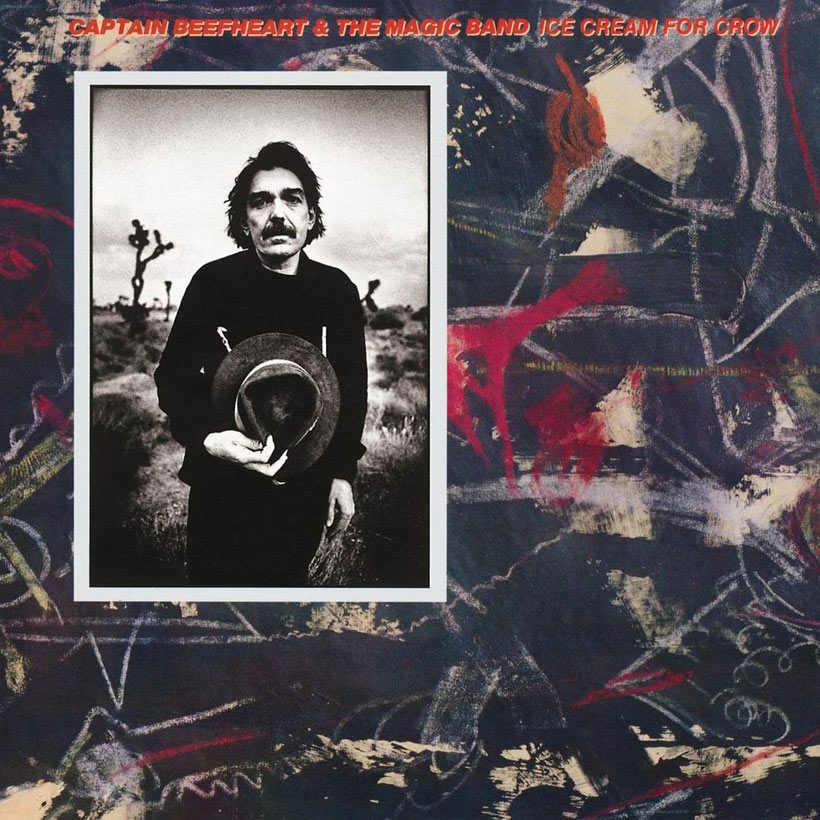‘Ice Cream For Crow’: The Sweet Treat Of Captain Beefheart’s Final Album
After releasing ‘Ice Cream For Crow,’ Captain Beefheart retired from music-making in order to channel his creativity through painting.

It’s perhaps fitting that Captain Beefheart’s final album, Ice Cream For Crow, released in September 1982, was his first to make a dent on an album chart since 1974’s Unconditionally Guaranteed hit No.192 in the US. It had been even longer – a full 10 years – since Beefheart found favor on the UK charts, when The Spotlight Kid peaked at No.44. In 1982, Beefheart’s UK fanbase rallied again, taking his final ever album to No.90.
Listen to Ice Cream For Crow now.
With the likes of Public Image Limited and other heroes of the late 70s/early 80s new wave citing him as an inspiration, perhaps the world was finally ready for Beefheart’s organized chaos. His label, Virgin, certainly thought so, not only releasing the title track as a single, but going so far as to film a promo video for it. Yet the clip was rejected by MTV, who found its fractured imagery – much like Beefheart’s lyrical excursions – too baffling to put on rotation. Yet, as David Fricke noted in his review for Musician, the album was “at once giant steps ahead of today’s plague of synthetic funk records” – the music that was getting traction on MTV, after Prince kicked the door down with “1999” – “yet still deeply rooted in its elemental John Lee Hooker rasp.”
Those au fait with Beefheart’s Trout Mask Replica would find much to enjoy in Ice Cream For Crow’s rawest moments, such as “The Thousandth And Tenth Day Of The Human Totem Pole” (with fantastic soprano sax skronk from the Captain), a song re-recorded from the 1976 Bat Chain Puller sessions. Yet … Crow also found Beefheart in transition. His wild-man vocals are let loose on the likes of “The Past Sure Is Tense,” but, more often than not – as on “… Totem Pole” and “Hey Garland, I Dig Your Tweed Coat” – he speaks his lyrics with measured cadence.
Behind him, however, The Magic Band are reliably raucous. Future Lydia Lunch and Red Hot Chili Peppers sticksman Cliff Martinez provides solid, if reliably wayward drum patterns which Rolling Stone identified as sounding “as orderly as coconuts hitting the ground.” Having proven his worth on Doc At The Radar Station, Gary Lucas is once again on hand to unleash his wiry guitar lines, his solo showcase, “Evening Bell,” emerging as a career-high apparently transcribed (and played to perfection) from Beefheart’s own avant-garde piano template.
Beefheart had initially hoped to use original recordings from the shelved Bat Chain Puller tapes to make up much of Ice Cream For Crow, though Frank Zappa, who had recently finally settled with Herb Cohen after years of disputes over the ownership of the tapes, refused to grant his former charge the rights to use them. Forcing Beefheart to largely work up new material seems to have been a good thing, though. With fervent energy, “Skeleton Makes Good” was written in just one night, and Rolling Stone found that the album boasted some of Beefheart’s “most aggressive, angular music” since Trout Mask Replica.
The promo video for “Ice Cream For Crow” might have given MTV the horrors, but it was, perhaps more satisfyingly, accepted into New York’s Museum Of Modern Art. Beefheart’s best music had never been made for commercial consumption (notoriously, when he tried, he lost swathes of his fanbase); he was a bona fide artiste – a natural visionary who had no choice but to follow his muse. Which is why, after Ice Cream For Crow emerged, he suddenly disappeared, renouncing music-making for the rest of his life as he focused on his painting.
The signs had all been there – after all, Beefheart’s paintings had begun to grace his album covers with increasing regularity. It’s likely he always planned for Ice Cream For Crow to be the last word. For that album’s artwork, one of his paintings serves as the backdrop for a photo by Anton Corbijn, in which it’s not hard to see Beefheart’s pose being something of a final bow. Or, as Rolling Stone put it: he wears an expression that conveys “the wounded fright of a hunted animal” – an animal ready to take flight.












